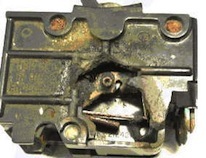Federal Pacific Electric panels known problems
- Breakers do not always trip when circuit is overloaded
- Breakers arc to the buss bar and damage it
- Breakers are damaged by arcing and heat
- Replacement breakers are expensive
- Breaker failure can cause electrical fire

SHOULD FEDERAL PACIFIC ELECTRIC STAB-LOK® PANELS BE REPLACED?
Below is a excerpt of an article prepared for the 17th Annual Spring Seminar, Feb. 21, 2004 St. Louis Chapter, American Society of Home Inspectors by J. Aronstein, Consulting Engineer, Mechanical and Materials Engineering BME, MSME, Ph.D., N.Y.S. P.E. LIC. NO. 39860, 50 Pasture Lane, Poughkeepsie N.Y. 12603.
If we inspected your home and found that it had a fuse box with 1/3 of the circuits over-fused or with pennies behind the fuses, how long would it be before you had it corrected? Would you sleep tight without it being corrected? Would the fact that your house had not had any problem (burned down yet) because of the over-fusing and pennies influence your decision as to whether or not to take corrective action?
Unlike over-fusing and pennies behind the fuses, defective FPE breakers cannot be spotted by an inspector or tested by an electrician or homeowner. Without doing a functional test (at overload and short-circuit conditions) on each breaker, one pole at a time for the two-pole breakers, one cannot actually determine the present operating characteristics of a breaker. Most electricians or electrical inspectors can only look at the breakers ("they look OK to me"), and operate the toggle ("they click on and off OK"). But without doing live-current functional testing on all of the breakers, it is impossible to determine which of the breakers in the panel are defective. Will they all trip properly on electrical overload or short circuit? Electrical contractors and inspectors are generally not equipped to do that type of testing, and homeowners or potential purchasers are not likely to have the required budget for extensive specialized testing. In fact, thorough testing would most likely cost far more than changing the panel.
The presence of an FPE panel in a home should be classified as a “Safety Defect”. The FPE breakers are primary safety devices of questionable operating reliability. It is not quite correct to call the non-tripping breaker a “fire hazard”. That term should be reserved for the electrical failure that causes ignition. The breaker’s function is to stop certain electrical sequences that could, if allowed to proceed, lead to fire in the building. If an electrical fire hazard develops somewhere in the building, the breaker is supposed to trip and minimize the possibility of fire ignition. If the breaker is defective, fire is more likely to result.
There is no question but that the FPE STAB-LOK® panels should be replaced. There is no practical and safe alternative. Call Creager Electrical Services today for FPE panel replacement at (703) 698-7654.
REFERENCES
- "Failure Analysis of Residential Circuit Breaker Panel", Wright-Malta Corp., (by J. Aronstein, for U.S. Consumer Product Safety Commission, Project #CPSC-C-81-1455), May 20, 1982 (Contains failure analysis of FPE Stab-Lok® panel that ignited, due to failure of buss-bar interconnections in the backside of the panel.)
- "Final Report: Calibration and Condition Tests of Molded Case Circuit Breakers", Wright-Malta Corp., (by J. Aronstein, for U.S. Consumer Product Safety Commission, Project #CPSC-C-81-1429), December 30, 1982 (Extensive calibration and functional testing of FPE breakers. Substantial percent failures to trip on overload.).
- "Status Report - Evaluation of Residential Molded Case Circuit Breakers", Wright-Malta Corp., (by J. Aronstein, for U.S. Consumer Product Safety Commission, Project #CPSC-C-81-1455), August 10, 1982 (Contains analysis of mechanism of failure of FPE two-pole Stab-Lok® breakers.)
- "Phase II Report, Evaluation of Residential Molded Case Circuit Breakers", Wright-Malta Corp., (by J. Aronstein, for U.S. Consumer Product Safety Commission, Project #CPSC-C-81-1455), March 10, 1984 (Contains experimental analysis of materials, construction, and performance of molded case circuit breakers, including FPE. Lack of corrosion resistance of certain internal parts is considered to be a factor in the failure of the circuit breakers.)
- Reliance Electric Company press release re: FPE Breakers, July 5, 1980
- "Exxon Buys a Scandal Along With A Company", Business Week, July 21, 1980, p. 66
- www.inspect-ny.com/fpe/fpepanel.htm, Federal Pacific Electric Stab-lok Circuit Breaker & Panel Information Website
- EMail to D. Friedman (manager of site of Reference 7)
- CPSC press release, March 3, 1983
- "Federal Pacific Electric Co. Stab-lok® Update", IAEI News, May/June 1999 p. 16



